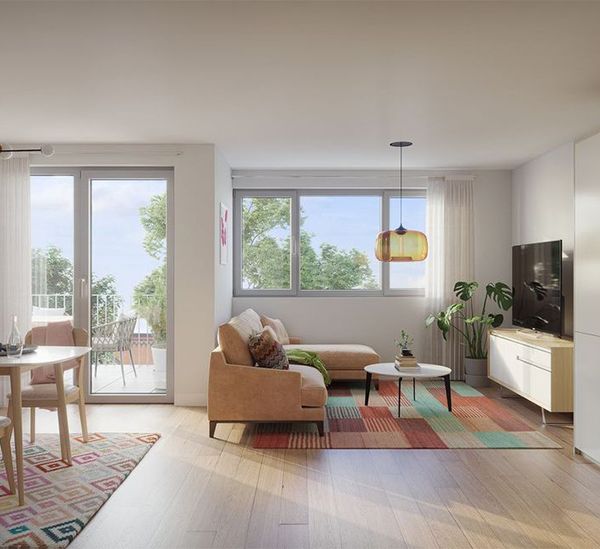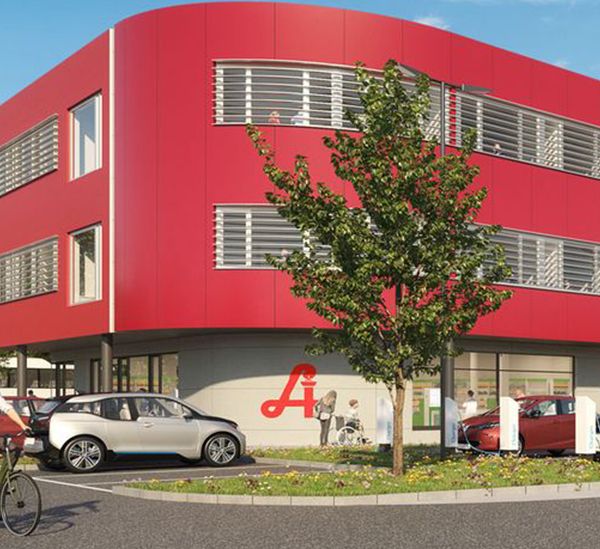Quality of Life through Proximity
- Topic
- Inspiration & Information
- Date
- 10.03.2021
As a real estate developer, we spend a lot of time thinking about the revitalization of our streets and urban life in general. Work and living spaces, childcare spaces, places for the needs of daily living, private and public greenspaces … in brief—urban environments and everything that goes with them. We believe that the future of sustainable urban development is in mixed uses. But what exactly does that mean, and what does it consist of?
A FORMULA FOR THE FUTURE
The following examples of two people in everyday situations illustrate the benefits of mixed use well: Take, for example, an elderly lady with limited mobility who lives in a nursing home. In order to run her daily errands, visit the doctor, and maintain her social contacts, she needs assistance. This is because, to reach the distant shops, doctor’s offices, or even just a café, she needs someone to pick her up and bring her there. However, all that will soon change because her nursing home is located in Traun Dionysen, where we are currently constructing a mixed-use Health and Neighborhood Center (STZ) right nearby. In just a few months, she will be able to go shopping there, visit the doctor, fill her prescription at the pharmacy, or meet friends and her grandchildren at the coffee shop. This is, in a nutshell, the epitome of “quality of life through proximity”.
Another good example of someone who benefits from the traditional mixed-use model is a young mother dropping her child off at kindergarten on the way to work: When work, the apartment, and childcare are all within walking distance—or even in the same building—time and resources are saved. AVORIS has already built this model of the future in Leoben at the Kremplhof, where living space, office space, and a café all complement each other quite successfully. In the Vienna Urban Oasis in the 15th district and The Blend in Favoriten, AVORIS is using the mixed-use principle as its central planning approach.
From a technical point of view, the factor that contributes most to the improved quality of life of all of these projects is simple: It’s the mixed use. By mixed use, we mean using the areas of a building in multiple different ways—for example, for commercial, sports, leisure, dining, or social services on the ground floor, and apartments above. This often results in an integration of the private and professional areas of life.
A simple principle ...
Of course, the term “mixed use” can also be used more broadly, by applying it to a street or a neighborhood. If living and working, shops, childcare, leisure activities, private open spaces, and public greenspaces are all within a short distance, the quality of life improves considerably.
Mixed use has another very important advantage: It is based upon the principle of sustainability. It is obvious that mixed use substantially reduces private transport, thus saving personal time, resources, and so much more. In addition to the environmental and social benefits of mixed use, stable use levels and steadier property values also line up in its favor. And for property owners, mixed use brings a diversification that ensures stability for renting.
...for a complex ecosystem
These are the reasons that we here at AVORIS are passionate about pursuing the mixed use concept wherever possible—and wherever it makes good business sense. Because no one is saying that mixed use just falls from the sky. It is a complex ecosystem, and bringing it to life is a complicated process.
Real estate developers must be ready to go the proverbial extra mile. In order for a mixed use to actually work, there must be in-depth dialogue with the various user groups to ascertain their needs and wishes, and intensive communication between developers, special planners, and municipalities is required even in the earliest phases of development.
However, we are convinced that these investments will pay off. We believe that ensuring the success of the overall project will create added economic value. The result is attractive living spaces; sustained high demand is the return.
A worthwhile balancing act
This is often a balancing act. Ultimately, it is important to balance the interplay of private and communal areas in such a way that life in the neighborhood works. The interaction of factors such as mobility, energy, natural resources, infrastructure, greenspace, and opportunities to improve work-life balance determine the desirability of a living space.
The comparison makes it clear
The merit of this balancing act becomes clear once you experience the opposite—let’s call it separate, divided, or single use. Dead ground floor zones and empty city centers, residential and commercial districts plagued by commuter traffic, and sprawling suburban shopping centers are diametrically opposed to the idea of creating village life in a neighborhood. That’s why AVORIS has sharpened its focus on mixed use. Housing has always been and still remains our most important focus. Now, however, we realize it in combination with mixed use. We are doing this because our company is convinced that this is the only way to make city life worth living in the future. Mixed use is the future of successful urban development.




















